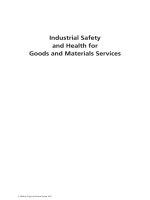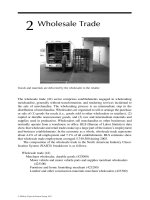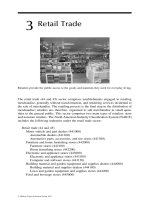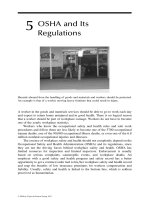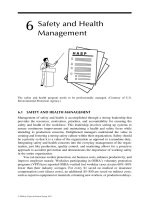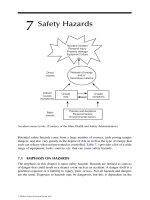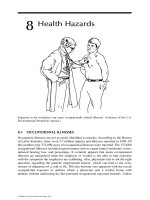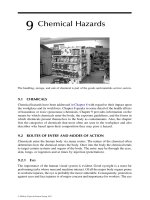Industrial Safety and Health for Goods and Materials Services - Chapter 18 doc
Bạn đang xem bản rút gọn của tài liệu. Xem và tải ngay bản đầy đủ của tài liệu tại đây (137.06 KB, 14 trang )
18
Machine Safety
According to National Institute for Occupational Safety and Health’s (NIOSH)
National Traumatic Occupational Fatality (NTOF) data from 1980 to 1998 occupa-
tional injury from machinery was ranked third after motor vehicle and homicide as
causes of death. Fatalities from machine-related incidents accounted for approxi-
mately 13% of the total. The service industry did not rank among the highest sectors
having machine-related incidents. Some of the leading injuries experienced in these
industries were as follows: struck by or against an object, caught in or compressed by
equipment, and caught in or crushed in collapsing materials.
According to the Bureau of Labor Statistics (BLS), 92,560 private-sector lost-
time injuries during the year 2002 were caused by machinery. The median number of
lost workdays resulting from these injuries was 7 with 24% of the total incidents
resulting in 31 or more lost workdays. The type of machine (source) most often
identified included metal, woodworking, and special materials machineries (19,269
injuries); material handling machinery (16,183 injuries); speci al process machinery
(15,576 injuries); heating, cooling, and cleaning machineries (13,330 injuries);
unspecified machinery (6148 injuries); and construction, logging, and mining
machineries (6069 injuries). Machinery was identified as the primary source of
fatal occupational injuries in 483 of 5915 total fatalities during 2002.
The safe operation of all types of equipment takes a variety of approaches
since the manufacturer cannot always be depended upon to provide inherently
Material handling equipment is usually guarded during manufacturing, and must be
operated safely.
ß 2008 by Taylor & Francis Group, LLC.
safe machines. It is often up to the owner (employer) to ensure that the machine=
equipment is as safe as possible for their employees to operate. This may require that
specific redesign of safeguards, unique training, and safe operating procedures
(SOPs) be developed.
18.1 GUARDING
Although a more detailed approach to safeguard is found in Industrial Safety and
Health for Administrative Services and Industrial Safety and Health for People-
Oriented Services, a short review has been placed in this chapter. Any mobile
machine part presents a hazard. Guarding eliminates or controls this danger. The
most dangerous machine motions are rotating; reciprocating= transverse motions; in-
running nip points; cutting actions; and punching, shearing, and bending. The types
of machine guards and their uses are summarized as follows:
.
Enclosure guards are preferable to all other types because they prevent
access to dangerous moving parts by enclosing them completely. They are
used on power presses, sheet leveling or flattening machines, milling
machines, gear trains, drilling machines, etc.
.
Fixed guards may be adjustable to accommodate different sets of tools or
various kinds of work. However, once they have been adjusted, they should
remain ‘‘fixed.’’
.
Interlocking guards are the first alternative when fixed guards or enclosures
are not practicable. They prevent operation of the control that sets the
machine in motion until the guard or barrier is moved into position .
.
Barrier that shuts off or disengages power, preventing the machine from
starting when the guard is open.
Electric contact or mechanical stop that activates a brake when any part of the
operator’s body enters the danger zone:
.
Two-handed tripping devices are commonly used on bakery machinery,
guillotine cutters, power presses, dough mixers, centrifugal extractors,
tumblers, and some kinds of pressure vessels.
.
Automatic guards must prevent the operator from coming in contact with
the dangerous part of the machine while it is in motion, or must be able to
stop the machine in case of danger. Examples of these are pull-away or
hand-restraint devices; and photoelectric relay switches that stop the power
supply to the machine.
.
It is important that machines=equipment controls be properly adjus ted and
maintained.
.
Remote control, placement, feeding, ejecting may be used to protect the
operator from dangerous points of operation. Examples are two-handed oper-
ating devices; chutes, hoppers, conveyors, etc., to feed stock automatically;
ß 2008 by Taylor & Francis Group, LLC.
and special jugs or feedi ng de vices made of met al or wood ; mecha nical or
air-operat ed eject ing device s may be used to compleme nt anothe r type of
guard or as a subst itute.
18.2 SAFE PRACTICES REGARDING MACHINE GUARDS
No guard, barrier, or enclosu re should be adjus ted or remo ved for any reason by
anyone other than a n author ized person. Before remo val of safegu ards for repairs,
adjustm ents, or servi cing, the power must be turne d off and the main switch locked
out and tagged . No machi ne shoul d be started unles s the guards are in place and in
good condit ion. Def ective or missin g guards shoul d be report ed to the superv isor
immediatel y. Emplo yees shoul d not work on or around mecha nical operat ing equ ip-
ment while wear ing neck ties, loose clothing, watches, rings, or other jewelry .
18.3 TRAINING
All wor kers shoul d receive machine=equipme nt speci fic trai ning. The y shoul d be
trained on the speci fic piece of eq uipment that they are going to be operating. If they
have not operat ed the equipm ent for a long time, they should recei ve renewed training.
It is a superv isor s’ responsibi lity to make safe job observatio n to determin e if the
employee is still pro fi cient on the safe operation of the machine or equipm ent. If not,
the superv isor must have the employ ee retrained or give hands- on training to ensure
the safe operat ion of the machi ne or equipm ent. One of the most importan t pieces of
information that can be used to both check and retrain wor kers is an SOP for a piece of
equipment or machine. An SOP should exist for all pieces of equipment or machine.
18.4 SAFE OPERATING PROCEDURES
Safe operat ing procedu res or stand ard operat ing procedu res shoul d incl ude safet y as
a part of the standard operat ing pract ices, which are delineated within it. Worker s
may not automati cally unders tand a task just because they have e xperience or
training. Thus, many jobs, tasks, and operations are best supported by an SOP.
The SOP walks the worker through the steps of how to do a task or procedure in a
safe manner and calls attention to the potential hazards at each step.
You might ask why an SOP is needed if the worker has already been trained to
do the job or task. As you may remember from Cha pter 17, a job safety analys is
usually keys in on those particular jobs which pose the greatest risk of injury or
death. These are the high- risk types of work activities and definitely merit the
development and use of an SOP. There are times when an SOP, or step by step
checklist, is useful. This is the case when
.
New worker is performing a job or task for the first time.
.
Experienced worker is performing a job or task for the first time.
.
Experienced worker is performing a job, which he=she has not done
recently.
ß 2008 by Taylor & Francis Group, LLC.
.
Mistakes co uld cause damag e to equipment or proper ty.
.
Job is done on an intermi ttent or infr equent basis .
.
New piece of equipment or diff erent model of equipment is obtai ned.
.
Supervi sors need to unders tand the safe ope ration to be able to evalua te
performanc e.
.
Procedur e o r acti on wi thin an o rganizati on is repetitive.
.
Procedur e is crit ically imp ortant, no mat ter how seldo m perfor med, be
carried out exactl y according to detailed, step- wise instruct ions.
.
Need to standardiz e the way a procedu re is carri ed out for ensuring quali ty
control or syst em compa tibili ty.
When airl ine pilots fly, the most critical parts of the job are takeof fs and landings.
Since these are two very critical aspects of fl ying, a checkl ist for proceed ing in a safe
manner is used to mit igate the potential for mis takes. It is crit ical to provide help
when a chance for error ca n resul t in grave consequ ences.
Plastici zed SOPs should be placed on equipm ent, machi nes, and vehicl es for
those individua ls who need a refres her before operation because they have not used
the equipm ent or performed the task on an infr equent basis .
Few people or wor kers want to admit that they do not kno w how to perfor m a job
or task. They will not ask questions , let alone a sk for help in doing an assi gned task.
This is the time when a plast icized SOP or checklist could be placed at the wor ksite
or attached to a piece of e quipment . This can prove to be a very effective accide nt-
prevention technique . It can safely walk a worker throu gh the correct sequenc e of
necessa ry steps and thus avoid the exposur e to hazards whi ch can put the wor ker at
risk of inju ry, ill ness, or death.
These SOPs could be used when , for examp le, heli copters are used for lif ting,
industri al forklifts are used, material s are moved manua lly, etc. These types of SOPs
should list the sequent ial steps requi red to perform the job or task safely, the potent ial
hazards invol ved, and the person al prote ctiv e equipm ent needed. Each step in the
SOP shoul d provide all the informat ion needed to acc omplish the task safel y.
If you do not have annu al training, the use of SOPs may instil l a sense of
con fidence and refresh workers ’ mem ories for the task at hand.
Any update d procedu re shoul d be re flected in the SOP imm ediately to ensure its
effective appli cation. A checkl ist is one form of an SOP. A checkl ist is very effective
and atte mpts to ensure that every step is foll owed.
SOPs are only useful when they are up-to-date and readi ly access ible at the
actual job or task site. Since we can now store SOPs online, revision and modi fica-
tion, based on wor kers=superv isors ’ suggestio ns, are much simpler. Figure 18.1
depicts a typical forklift and Table 18.1 depicts an SOP for a forklift . Usi ng the
format from this example, develop your own SOPs for procedures, jobs, tasks, or
equipment.
An SOP is only one accident-prevention technique or component of any safety
and health initiative. There are specific jobs or tasks that lend themselves well to this
approach. Make sure that you use SOPs when they benefit your type of work the
most and not as a cure-all for all your accidents and injuries. Use it as one of the
many tools for accident prevention.
ß 2008 by Taylor & Francis Group, LLC.
FIGURE 18.1 Forklift.
TABLE 18.1
An SOP for a Forklift
What To Do How To Do It Key Points
Perform a pre-start
up inspection
Walk around the vehicle checking
overall conditions of:
1. Tires 1. Check tires to ensure adequate tread, no
cuts=missing chunks, all tire bolts are
present and are tight.
2. Fluid leaks 2. Check hydraulic hose fittings for
evidence of fluid leak. Look beneath
vehicle for fluid on the floor.
3. Overhead guard 3. Check for missing bolts, bent frame.
4. Lifting forks and load backrest 4. Check the lifting forks and backrest for
damage. Check that the lifting fork’s
width adjustment lock pins are in good
condition and are working smoothly.
5. Preventive maintenance (P=M)
sticker
5. If P=M expiration date is not valid, do
not operate vehicle.
Perform operating
controls inspection
1. Sit in driver’s seat and operate
controls
1. Check to ensure emergency brake is
engaged and gear shift is in park or
neutral.
2. Adjust seat for effective
operation and comfort
2. Seat should be adjusted to allow foot
brake pedal to be depressed without
reaching with foot.
(continued)
ß 2008 by Taylor & Francis Group, LLC.
TABLE 18.1 (continued)
An SOP for a Forklift
What To Do How To Do It Key Points
Perform operating
controls inspection
(continued)
3. Fasten seat belt 3. Seat belt should be snugly across hips.
4. Turn on power to vehicle 4. Check 3608 around vehicle to ensure no
one is standing near vehicle.
5. Turn on headlights 5. Headlights must be bright and in
position to ensure being seen by other
vehicle operators or pedestrians.
6. Depress brake foot pedal 6. The pedal must be firm and brake lights
must function and be bright.
7. Depress horn button
8. Elevate lifting forks and tilt by
pulling back on control levers
7. Horn should function easily and be
loud.
8. Hydraulic controls shall operate
smoothly.
9. Lower lifting forks to 2–4 in.
above fl oor
10. Report any safety check failure
to supervisor immediately for
repair
9. Keep lifting forks 2–4 in. above surface
when in motion.
10. Do not operate if any safety check fails.
Ensure the vehicle is not operated until
repaired.
Operating
procedure—
traveling to
designation
1. Depress foot brake pedal 1. Check 3608 around vehicle to ensure no
one is standing near vehicle. Keep
lifting forks 2–4 in. above surface when
in motion.
2. Release parking brake 2. —
3. Select direction of travel 3. Engage gear drive. Check travel
direction to ensure path is clear of
pedestrians or other vehicles.
4. Remove foot from brake pedal 4. Remove foot slowly.
5. Depress accelerator pedal 5. Depress accelerator pedal slowly
to avoid quick, jerky start. Keep lifting
forks 2–4 in. above surface when in
motion.
6. Obey safety rules and
regulations
6.
.
Travel at speeds which allow vehicle
to be under control at all times under
any condition.
.
Travel single-file keeping to the right.
.
Pedestrians have right of way.
.
Emergency vehicles have right of
way at all times.
.
Use lights and horn when necessary.
.
Allow at least 15 ft or three vehicle
lengths between you and person in
vehicle (PIV) in front.
ß 2008 by Taylor & Francis Group, LLC.
TABLE 18.1 (continued)
An SOP for a Forklift
What To Do How To Do It Key Points
Operating
procedure—
traveling
to designation
(continued)
.
Do not pass other vehicles traveling
in the same direction at intersections
or blind spots, or narrow passages.
.
Ensure there is adequate overhead
clearance.
.
Do not travel over objects.
.
Avoid sudden stops, except in
emergencies.
.
Stop at all stop signs, blind corners,
or when entering intersecting aisle
and look for pedestrians and vehicle
traffic.
Operating
procedure—
material pick-up
1. Approach material slowly 1. Reduce speed to avoid sudden stop.
2. Stop vehicle, depress foot
brake pedal
2. Apply slow, steady pressure until
vehicle stops.
3. Shift to park or neutral 3. Never select direction while in motion.
4. Engage parking brake 4. If on an incline block wheels.
5. Unfasten seat belt and
dismount, set forks for
maximum load width
5. Know the vehicle’s capacities and load
weights.
6. Remount and fasten seat belt 6. Seat should be adjusted to allow foot
brake pedal to be depressed without
over extending.
7. Depress foot brake pedal 7. Check 3608 around vehicle to ensure
no one is standing near vehicle.
8. Release parking brake 8. —
9. Select direction of travel 9. Engage gear drive. Check travel
direction to ensure path is clear.
10. Remove foot from brake pedal 10. Remove foot slowly.
11. Depress accelerator pedal 11. Depress accelerator pedal slowly to
avoid quick, jerky start.
12. Approach the load with lifting
forks level
12. Lifting forks should be parallel with
walking surface.
13. Penetrate forks to back of
pallet
13. The pallet should be set against the
backrest.
14. Depress foot brake pedal
bringing vehicle to a stop
14. Apply slow steady pressure until
vehicle stops.
15. Raise the lifting forks until
pallet is 2–4 in. above walking
surface
15. Never raise forks while in motion.
(continued)
ß 2008 by Taylor & Francis Group, LLC.
TABLE 18.1 (continued)
An SOP for a Forklift
What To Do How To Do It Key Points
Operating
procedure—
material pick-up
(continued)
16. Tilt the lifting forks back
slightly
16. Tilt the forks backward slightly to
prevent the load from falling forward.
17. Select direction of travel 17. Engage gear drive. Check travel
direction to ensure path is clear of
pedestrians or other vehicles.
18. Remove foot from brake pedal 18. Remove foot slowly.
19. Depress accelerator pedal 19. Depress accelerator pedal slowly to
avoid quick, jerky start.
20. Travel carefully to
designation, obeying rules and
regulations
20. Travel at speeds which allow vehicle
to be under control at all times under
any condition.
.
Travel single-file keeping to the
right.
.
Pedestrians have right of way.
.
Emergency vehicles have right of
way at all times.
.
Use lights and horn when necessary.
.
Allow at least 15 ft or three vehicle
lengths between you and PIV in
front.
.
Do not pass other vehicles traveling
in the same direction at intersections
or blind spots, or narrow passages.
.
Ensure there is adequate overhead
clearance.
.
Do not travel over objects.
.
Avoid sudden stops, except in
emergencies.
.
Stop at all stops sign, blind corners,
or when entering intersecting aisle
and look for pedestrians and vehicle
traffic.
.
Always drive with load facing up
hill.
.
Drive backwards when view is
obstructed by large loads.
Operating
procedure—
material drop-off
1. Depress foot brake pedal
bringing vehicle to a stop
1. Apply slow steady pressure until
vehicle stops.
2. Shift to park or neutral 2. Never select reverse while in motion.
3. Tilt forks forward until parallel
with walking surface
3. Never lower forks while in motion.
ß 2008 by Taylor & Francis Group, LLC.
TABLE 18.1 (continued)
An SOP for a Forklift
What To Do How To Do It Key Points
Operating
procedure—
material drop-off
(continued)
4. Lower lifting forks until pallet
bottom is resting on surface
and forks no longer support
load
4. Lower load slowly to prevent sudden
drop.
5. Engage reverse drive 5. Check 3608 around vehicle to ensure
no one is standing near vehicle.
6. Remove foot from brake pedal 6. Engage gear drive. Check travel
direction to ensure path is clear of
pedestrians or other vehicles.
7. Depress accelerator pedal 7. Depress accelerator pedal slowly to
avoid quick, jerky start.
8. Travel enough distance until
lifting forks can clear pallet
8. Travel in reverse until there is enough
distance between the end of lifting
forks and pallet.
9. Depress foot brake pedal
bringing vehicle to a stop
9. Apply slow steady pressure until
vehicle stops.
10. Engage forward drive 10. Check 3608 around vehicle to ensure
no one is standing near vehicle. Never
select directional change while in
motion.
11. Remove foot from brake pedal 11. Check travel direction to ensure path is
clear of pedestrians or other vehicles.
12. Depress accelerator pedal 12. Depress accelerator pedal slowly to
avoid quick, jerky start.
13. Travel carefully to designation
obeying rules and regulations
13.
.
Travel at speeds which allow vehicle
to be under control at all times under
any condition.
.
Travel sin gle- file keeping to the right.
.
Pedestrians have right of way.
.
Emergency vehicles have right of
way at all times.
.
Use lights and horn when
necessary.
.
Allow at least 15 ft or three vehicle
lengths between you and PIV in
front.
.
Do not pass other vehicles traveling
in the same direction at
intersections or blind spots, or
narrow passages.
(continued)
ß 2008 by Taylor & Francis Group, LLC.
18.4.1 COMPONENTS OF AN SOP
SOPs should provide clear instruct ions for safely conducting activities involved in
each covered process, consistent work activity using the appropriate manufacturer’s
guidelines and instructions, other pertinent safety resources information, and exper-
tise of the individual with specific safety knowledge to addres s at least the following
elements:
1. Steps for each operating phase
a. Initial startup
b. Normal operations
c. Tempor ary operations
d. Emergen cy shutdown including the conditions under which emergency
shutdown is required, and the assignment of shutdown responsibility to
TABLE 18.1 (continued)
An SOP for a Forklift
What To Do How To Do It Key Points
Operating
procedure—
material drop-off
(continued)
.
Ensure there is adequate overhead
clearance.
.
Do not travel over objects.
.
Avoid sudden stops, except in
emergencies.
.
Stop at all stop signs, blind corners, or
when entering intersecting aisle and look
for pedestrians and vehicle traffic.
Operation
procedure—shut
down
1. Depress foot brake pedal
bringing vehicle to a stop
1. Apply slow steady pressure until
vehicle stops.
2. Shift to park or neutral 2. Never select directional changes while
in motion.
3. Engage parking park 3. If on an incline, block wheels.
4. Lower lifting forks slowly until
resting on walking surface
4. Never lower forks while in motion.
5. Turn off power 5. Remove key.
6. Release seat belt 6. —
7. Dismount 7. Wheels must be blocked if parked on an
incline.
8. Perform walk-around
inspection, noting damage or
operational problems
8. Report all operation problems to
supervisor for repair.
9. Remove all trash
Source: From Reese, C.D. Accident=Incident Prevention Techniques, Taylor & Francis, New York,
2001.
ß 2008 by Taylor & Francis Group, LLC.
quali fied operat ors to ensure that emer gency shutd own is execut ed in a
safe and timely manne r
e. Emergen cy op erations
f. Normal shutd own
g. Startup follow ing a turna round, or after an emerge ncy shutd own
2. Operating limit s
a. Consequen ces of deviat ion
b. Steps requi red to correct or avoid deviat ion
3. Safety and health consi derations
a. Properties of, and hazards presen ted by , the chemi cals used in the
process or hazards invol ved in the task
b. Precautions necessary to prevent exposure, including engineering controls,
administrative controls, and personal protective equipment
c. Control measures to be taken if physical contact or airborne exposure occurs
d. Quality control for raw mat erials, c ontrol of hazardo us chemical inven-
tory levels, and any other speci al or unique hazards
4. Safety syst ems and their functions
Safe or stand ard ope rating procedu res shoul d be readi ly access ible to employees who
work with or maintain a proces s or operation. The SOPs shoul d be reviewed as o ften
as necess ary to ensure that they refl ect curren t operat ing pract ice, incl uding any
updations in techno logy, equipment , and facil ities.
The empl oyer shoul d develo p and implem ent safe work pract ices to provid e for
the contr ol of hazards during operat ions such as e quipment=machi ne operation,
lockout=tagout; con fined space entry ; openin g proces s eq uipment or piping; and
control over an entra nce into a facility by maintenan ce, contr actor, labor atory, or
other suppor t person nel. The se safe wor k practices must apply to employe es and
contractor employees.
18.4.2 GUIDELINES FOR WRITING AN SOP
SOPs are often poorl y written because little though t or effor t is made to do it right. At
times they are manda ted as a quick fix for a percei ved problem. An organized and
thoughtful ap proach wi ll yield SOPs whi ch are more practical . Her e are some
guidelines for writing an SOP:
.
Decide what SOPs must be writt en based on a revie w of organi zationa l
functions.
.
Check for any existing SOP that can be revised or updated.
.
Gather information on the procedure from reference sources and know-
ledgeable employees.
.
When possible, contact other agencies performing similar functions to see if
they have an SOP and use it as a guide.
.
Select a suitable form at for the SOP to be writt en (e.g., Tab le 18.1).
.
Assemble blank forms and any other documents to be referred to in the SOP.
ß 2008 by Taylor & Francis Group, LLC.
.
Write a draft of the SOP. Include copies of any blank forms referred to in
the SOP.
.
Review or have a fellow employee review the draft SOP for technical
adequacy.
.
Request that the draft SOP be reviewed for administrative adequacy by the
supervisor or the person in charge.
.
Incorporate any changes indicated by the reviews into a final draft.
.
Date, sign, assign a file number, and distribute the new or revised SOP. The
final copy should be signed both by the official responsible for preparing
the SOP and by the official’s supervisor or the official in charge. Copies
should be provided to supervisors and officers in charge of the immediate
organization, and should be posted in an SOP file for ready reference.
The most common problems and errors found in SOPs are summarized in the
following list:
.
Assigning responsibilities for carrying out a procedure rather than listing out
methods. Regulations are the place for delineating responsibilities, not SOPs.
.
Failure to clearly state specific responsibilities in the procedure. The ‘‘who’’
is as important as the ‘‘what.’’
.
Inclusion of steps or procedures performed by persons outside the organi-
zation. This information has no place in an SOP because it involves actions
which are beyond the direct control of the organization. Include only those
steps that are carried out by the employees in the immediate organization;
all else is irrelevant.
.
Vagueness and imprecision. What if the reader cannot figure out exactly
who (job description) is required to carry out a step in the procedu re, and
furthermore cannot determine precisely how it is to be carri ed out? Obvi-
ously, then, the SOP has failed in its primary objective, communication.
This is why the prime function of the reviewer is to check whether the
writer has conveyed his message clearly and unequivocally.
18.4.3 HOW SOPS WORK
Safe or standard operating procedures describe tasks to be performed, data to be
recorded, operating conditions to be maintained, samples to be collected, and safety
and health precautions to be taken. The procedures need to be technically accurate,
understandable to employees, and revised periodically to ensure that they reflect
current operations. Operating procedures should b e reviewed by engineering staff
and operating personnel to ensure that they are accurate and provide practical
instructions on how to actually carry out job duties safely.
Operating procedures will include specific instructions or details on what steps
are to be taken or followed in carrying out the stated procedures. These operating
instructions for each procedure should include the applicable safety precautions and
should contain appropriate information on safety implications. For example, the
operating procedures addressing operating parameters will contain operating
ß 2008 by Taylor & Francis Group, LLC.
instructions about pressure limits, temperature ranges, flow rates, what to do when an
upset condition occurs, what alarms and instruments are pertinent if an upset
condition occurs, and such other subjects. In some cases, different parameters will
be required from those of normal operation. These operating instructions need to
clearly indicate the distinctions between startup and normal operations such as the
appropriate allowances for driving while fully loaded.
Operating procedures and instructions are important for training operating per-
sonnel. The operating procedures are often viewed as the SOPs for operations.
Operators and operating staff, in general, need to ha ve a full understanding of
operating procedures. If workers are not fluent in English then procedures and
instructions need to be prepared in a second language understood by the workers.
In addition, operating procedures need to be changed when there is a change in the
process as a result of the management of change procedures. The consequences of
operating procedure changes the need to be fully evaluated and the information
conveyed to the personnel. For example, mechanical changes to the process made by
the maintenance department (like changing a valve from steel to brass or other subtle
changes) need to be evaluated to determine if operating procedures and practices also
need to be changed.
All management change actions must be coordinated and integrated with current
operating procedures and operating personnel must be oriented to the changes in
procedures before the change is made. When the process is shut down to make a
change, the operating procedures must be updated before startup of the process.
Operating personnel must be trained to handle upset conditions as well as
emergencies such as pump seal failures and pipeline ruptures. Communication
between operating personnel and workers performing work within the operating or
production area, such as nonroutine tasks, must also be maintained. The hazards of
the tasks are to be conveyed to operating personnel in accordance with established
procedures and to those performing the actual tasks.
REFERENCE
Reese, C.D. Accident=Incident Prevention Techniques. New York: Taylor & Francis, 2001.
ß 2008 by Taylor & Francis Group, LLC.
ß 2008 by Taylor & Francis Group, LLC.

